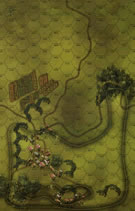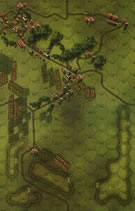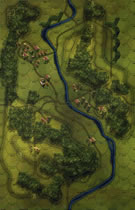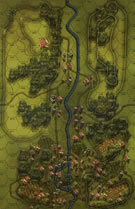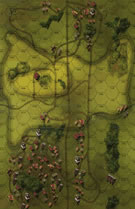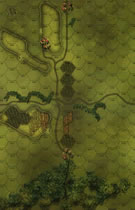|
Race to the Meuse Fall of France 1 #7 |
||
|---|---|---|
| (Attacker) Germany | vs | France (Defender) |
| Formations Involved | ||
|---|---|---|
| Germany |  |
7th Panzer Division |

| Total | |
|---|---|
| Side 1 | 8 |
| Draw | 3 |
| Side 2 | 1 |
| Overall Rating, 11 votes |
|---|
|
4.55
|
| Scenario Rank: 11 of 913 |
| Parent Game | Fall of France 1 |
|---|---|
| Historicity | Historical |
| Date | 1940-05-12 |
| Start Time | 08:30 |
| Turn Count | 52 |
| Visibility | Day |
| Counters | 207 |
| Net Morale | 0 |
| Net Initiative | 3 |
| Maps | 7: 27, 28, 29, 30, 31, 32, 33 |
| Layout Dimensions | 196 x 43 cm 77 x 17 in |
| Play Bounty | 177 |
| AAR Bounty | 141 |
| Total Plays | 12 |
| Total AARs | 6 |
| Battle Types |
|---|
| Covering Action |
| Delaying Action |
| Conditions |
|---|
| Off-board Artillery |
| Randomly-drawn Aircraft |
| Terrain Mods |
| Scenario Requirements & Playability | |
|---|---|
| Fall of France 1 | Base Game |
| Introduction |
|---|
|
On the evening on May 11, General Corap ordered the vanguard elements of the Division Legeres de Cavalerie in the Ardennes to fall back to the Meuse. The size and power of the enemy was simply too much for the French light cavalry divisions, and they were in danger of being encircled. The withdrawal was carried out early on May 12, with mobile elements covering the retreat of the slower units. |
| Conclusion |
|---|
|
The French infantry divisions on the Meuse were far from ready to hold the line at this stage, so the retreating units had to make a fighting withdrawal. Taking every possible advantage of terrain, the dragoons and chasseurs succeeded in slowing down the Germans so that the less-mobile French units could cross the Meuse in safety. Quite a few panzers were destroyed all along the different retreat routes, and a sole 25mm French anti-tank gun claimed no less than 12 German tanks destroyed in one day. Around 1600 the bridges at Dinant and Bouvignes were blown within view of the first approaching panzers, just after the last French elements had crossed to safety. |
| AFV Rules Pertaining to this Scenario's Order of Battle |
|---|
|
| 3 Errata Items | |
|---|---|

|
In 1940: Fall of France, the units show Direct Fire. All units are Indirect Fire. (rerathbun
on 2015 Jun 06)
|

|
The reduced direct fire value of the Heer HMG became 5-5 starting with Fall of France. (plloyd1010
on 2015 Jul 31)
|

|
The morale and combat modifiers of German Sergeant #1614 should be "0", not "8". (Shad
on 2010 Dec 15)
|
| Fancy a paddle (solo) | ||||||||||||
|---|---|---|---|---|---|---|---|---|---|---|---|---|
Unknown to Bangla while we played this FtF on VASSAL, I played it solo upstairs in my gaming room. This was because I though the Tony had not initially chosen the right strategy for the German forces and I wanted to try a different approach. As it happened in our FtF game Tony actually changed his tactics to similar to the one I was adopting and won our game. I my solo game the Germans did manage to cross the Meuse in some strength however lost more troops doing so meaning the result was another minor German win. See my comment on my FtF report on this very good scenario |
||||||||||||
| 0 Comments |
| Fancy a paddle | ||||||||||||||
|---|---|---|---|---|---|---|---|---|---|---|---|---|---|---|
This is the standout scenario from the Fall of France pack. 7 boards in file, 2 river crossings and loads of counters. The French forces are retreating to the far bank of the Meuse through the woods and hills of the Ardennes closely followed by the 7th Panzer division led by Rommel ( who in our game had a Geordie accent). The game does give the feel of commanding and manoeuvring large forces and there are lots of command decisions to make each turn. Even though I suspect it would take a lucky French commander to win this one I think playing the French was great fun. In the end the German tanks managed to trap enough French forces and destroy them, even though the Germans failed to cross the Meuse, for a minor win. Best large scenario I have played. Highly recommended and with VASSAL space is no longer an issue |
||||||||||||||
| 0 Comments |
| Blow those bridges now! | ||||||||||||
|---|---|---|---|---|---|---|---|---|---|---|---|---|
Battle: As elements of Divisions Légères de Cavalerie were ordered to fall back on May 12, 1940, they were pursued doggedly by the Rothenburg and Bismarck groups of the 7th Panzer Division. The French left a handful of dragoon units behind them in Marche-Famenne to cover the two most accessible bridges. At 0845, German HMG and artillery fire led to casualties on the north bridge, which was quickly reinforced in an effort to delay the German advance; however, German units pushed the dragoons off the central bridge by 0900 and controlled all three bridges by 0915. The large number of German units created some congestion due to a staunch defense by Lt. Gireaux with his dragoon platoons and 25mm portee units. By 1130, the Germans had a pontoon bridge north of Marche. With all four bridges operational, they had many units 2-3 Km west of Marche, but the main east/west road was still being obstructed by dragoon platoons that were holding their ground despite the loss of both portee units. At 1245, Lt. Gireaux fell, but his men still held both of their checkpoints. Over the next half hour, the French positions were lost, and the Germans headed westward. By 1400, the Germans continued to charge west and had cleared a key village of two 75mm French artillery units; however, the French engineers had reached Dinant and already had destroyed two of the five bridges into town. The German officers, seeing the smoke rising from the blown bridges with the day fleeting, urged their troops shouting “Bewegen! Bewegen Sie sich schneller! “. The race to the Meuse was on. Now the French chasseur and escadron units took over the delay tactics from the beleaguered dragoons. By 1530, a small number of German units had turned the north flank of the French line, but the chasseurs moved quickly to plug the gap. Shortly after 1700 hours, the French went to full retreat mode, and by 1730, the only bridge left across the Meuse was the one north of Dinant at Bouvignes-sur-Meuse. German motorcycle units found a backroad to the south and were in sight of the last bridge and engaging French forces on the east side of the river south of the bridge. As daylight was waning (1930 hours), they began to direct artillery barrages on the French units west of the Meuse. By 2030, the Germans had four Panzer units ready to fire on the engineers in the Bouvignes bridge, but the engineers blew the bridge first. After that, French HMG and AT fire seemed to erupt from everywhere in the town and surrounding woods, stunning the advancing Germans. Darkness fell just as a French cavalry platoon made it across a pontoon bridge arranged by the French engineers. Analysis: This scenario is a 7-map monster with a diverse unit force on both sides. It is 52 turns., which allows for extensive move and fire actions for both sides. All hill and field hexes are considered as woods, so LOS is very difficult when bombardment or aircraft are in play, and off-road travel is slowed for all units and not available for the wheeled ones. This makes it critical for the Germans to clear the roads as quickly as possible. For the first few hours, the French played a delaying action with their more mobile units, while setting up and digging in other units along the east/west road. Although there was a lot of unit congestion initially, the German effort was in blitzkrieg mode pushing west as soon as the bridges over the minor river by Marche could be controlled. Since the south bridge was left open, the Germans were eventually able to move foot and armored units along that road after crossing the ridge in the southeast corner of the map. Nonetheless, it took until Turn 9 for all the German units to enter the map. Single French dragoon platoons managed to block two key spots on the roadway despite repeated German assaults and adjacent hex fire. German armor and foot units were able to get around the roadblocks, but all the woods hexes made it difficult for the 23 truckloads of German units to make progress until the road was cleared. Once the German forces are all in play and well west of Marche, they represent a formidable force, having greater firepower, numbers and mobility on their side. Then, the real race to the Meuse begins, as the French need to get as many of their units west of the river while slowing the German advance. By Turn 20, the French had two engineer platoons prepared to begin to blow some of the south bridges; at the halfway point of the game, they had blown two of them with a third soon to follow. By Turn 39, all five south bridges were blown, and two French engineer platoons were just waiting until the time to attempt to blow the last (north) bridge. The last bridge was blown on Turn 49 leaving some French units stranded and giving VP’s to the Germans, but it had to be done as German units were adjacent to the bridge at that point. After that, the French had some very fortuitous die rolls in both assaults east of the river and AT shots. Neither side used smoke, and the French were helped by approx. half the turns ending early due to FOW. At game end, the French had exited 6 steps, had 22 more undemoralized steps west of the Meuse and had eliminated 48 German steps for a total of 76 VP’s; the Germans had eliminated 55 French steps with another 11 steps held east of the Meuse for a total of 66 VP’s. The 10 VP differential resulted in a French Minor Victory. One change that would be made if this were replayed would be to position the French H-35’s and portees closer to the Meuse, so that they could avoid early contact with the panzers. They represent 16 VP’s, so it would be better to use the 25 and 75mm guns up front, since they are only worth a single VP each. From the Axis standpoint, the units are probably best left on foot entering the map so that they can clear the east bridges and woods to provide a clear road for the trucks. That tactic may have sped up the German advance, but the large number of woods hexes is a general impediment to the German advance. While it may seem strange to rate such a complex scenario as excellent, this one is! It really gives the sense of an army in retreat trying to save units against an overwhelming force. The balance is handled well through the VP allotments, and it was very possible for this to go either way throughout the entire 52 turns. |
||||||||||||
| 4 Comments |
Great Read...thanks.... I hope Peter can come up with some Forest hexes to drop on maps for VASSAL... I much prefer to see the forests....
Great Read...thanks.... I hope Peter can come up with some Forest hexes to drop on maps for VASSAL... I much prefer to see the forests....
Thanks. I used the Woods hexes in the terrain drop-down, but there are a bunch of them to be placed. All of the hills and fields on the seven maps are considered woods. I think it took me 15-20 minutes just to lay down all the Woods terrain tiles!
It reminds me of a Crescendo of Doom scenario long ago called In Rommel's Wake. It was a fun scenario too. I like the better control in this one.
| French hold back the Germans, but not quite long enough! | ||||||||||||
|---|---|---|---|---|---|---|---|---|---|---|---|---|
Note: Score will be denoted by (x-y), where x=French casualties, y=German casualties. THE RACEThe French block the bridges with their armoured cars. The lead German PzII platoon is reduced by fire from the French (0-2) German panzers unload into the French armoured cars filling the bridges with wrecks, making them impassable to mechanized and motorized platoons. The Germans begin to cross the river aided by their engineers (7-2) The French attempt to hold the Germans up at the river. Fighting breaks out on the western shore in the wooded hills. (8-5) French are overrun by the river and suffer severe casualties. The Germans break through the wooded hills in the north and the French (artillery and anti-tank guns) fire lanes open in the fields beyond. (15-5) 2 hours have passed, 11 hours to go. Lead panzers are hit by anti-tank fire. German infantry advances against the French as the Trucks wait for passage across the river. In the far distance the retreating French are getting smaller and smaller… (20-8) An armour battle develops as the Panzers encounter the French H35s supported by some AT-Guns. Both sides lose a number of tanks. (32-14) The majority of French troops near the river are lost. They bought as much time as they could with their lives. Did they buy enough? 3 hours have passed, 10 hours to go. The French need to be careful that they don’t concede too many casualties. Their commander is worried that he committed too many forces at the river and that too many losses have already been sustained. The armour battle continues and soon the two easternmost sectors (boards) are almost completely French Free. (38–20) German armour is held up versus a large artillery and anti-tank gun line. (38-22) German motorcycles are sent to lead the charge against the gun positions. German trucks begin to head down the roads. Most of the Germans have now reached the second sector (map). The French lose the first of their anti-tank guns. As the German motorcycles begin to break through the French lines, most of the French guns limber up and fall back to avoid being encircled. German panzers charge and are hit by anti-tank fire as they try to overwhelm the remaining guns with combined arms. (41-24) Germans continue to advance as the French engineers reach the Meuse in the far distance. (42-26) 5 hours have passed, 8 hours to go. French AT Guns destroy more Panzers as the French Cavalry retreats down the wooded roads. One AT Gun battery remains on the French front line, which eliminates a PzI platoon! (44-32) At the Meuse, the first bridge is blown, as the front of the German column approaches the halfway point. Another Panzer is hit by the French AT-Gun before it is finally silenced by German artillery. German motorcycles and armoured cars intercept the French AT Guns in transport as the second bridge is blown at the Meuse. (45-34) German Armoured Cars eliminated by unlimbered AT-Guns. The last remaining H35s are destroyed in the woods by Pz38ts. French motorcycles are caught behind enemy lines. There is little in the German’s way now to the Meuse. (55-36) Two more bridges are blown as the Germans advance in the 4th sector. HALFWAY: 6.5 hours have passed, 6.5 hours to go. French are all but eliminated east of the Meuse except for some Cavalry with a French portee holding up about 2 km east of the river in a small village. (60-37) The French position themselves on the far shore. French portee is lost. (62-37) The Germans approach the river as the final bridge is blown. 2 French Cavalry and half a motorcycle platoon are stranded on the east side. 8 hours have passed, 5 hours to go. Some panzers are lost to a cavalry ambush in the woods as the majority of the Germans move around to the south. (63-39) Germans eliminate the French cavalry and approach the Meuse en masse. German engineers enter the river and get ready to assist the crossing. (68-39) More German engineers enter the river and they come under both HMG and artillery fire. The first German troops make it across the Meuse and are immediately reduced in assault with the French! (70-40) 10 hours have passed, 3 hours to go. Additional Germans cross the Meuse and are also reduced. The Germans continue to be hit trying to cross. Eventually 2 more platoons reach the west shore and the French manoeuvre to cut them off. (70-42) Victory is still in the air. I suspect it is near a draw at the moment, but can the French stem the approaching German tide? German casualties increase as they continue to cross the Meuse under fire. German armour begins firing across the river into the west shore and the French fall back. (71-46) 11 hours have passed, 2 hours to go. The final two hours sees the outgunned French troops begin to lose further numbers with only one more German casualty sustained. They are simply overwhelmed and unable to stem the flood. (79-47) The Race is Over!!! AftermathSo, who won? The significant French casualties and only a few platoons left suggests that the Germans have won. But by how much? French VPs: Germans Eliminated: 47 French on West Shore: 24 Total: 71 German VPs: French Eliminated: 79 Germans on West Shore: 31 Total:110 GERMAN MAJOR VICTORY!!! I have probably missed a few steps of casualties, but a victory by 39 VPs doesn’t seem to warrant a recount. I’m pretty convinced of the German Major Victory. So, what went right/wrong? I believe the French should not have tried to make a stand on the eastern river/town. A few pot shots, and fall back. Generally, I believe the French tried to hold ground too long, and therefore took such heavy casualties. If they had more forces at the Meuse they could have possible held the Germans back, particularly some AT Guns. With this said, they still needed to delay the Germans a bit longer. The German advance was at a crawl at some times and a sprint at others. Had the French been more spaced out, they may have been a tad more effective executing a fighting withdrawal and slowed the Germans to fast walk. This was truly a “Race to the Meuse”, and the Germans were too fast for the French. Had the scenario ended after 11 hours, I think it may have been a draw, or even a French victory. So it was close. Scenario Rating: 4/5 It is quite long, and in this reply got a bit bogged down at the end. But otherwise a great scenario. Well done fighting withdrawals are fairly rare, and this is a good one. |
||||||||||||
| 0 Comments |
| Whew! |
|---|
|
This scenario is a marathon, both in duration (50 turns is pretty long) and distance (7 mapboards laid side-to-side). Its a nice tactical puzzle as well. The French need to retreat as many units across the river on the farthest board, and prevent the Germans from crossing the same river. In my replay, the French cavalry and motorcycles, stiffened by a/t guns, artillery and a few tanks, did a good job of stalling the German onslaught at the wooded ridge at the eastern end of the map. The French decimated the light Panzer 1s and 2s as they struggled through the difficult ground in a futile flanking attack on the French defense. German infantry bogged down trying to root out the French defenders, forcing the follow-on German forces to deploy on the north flank and sweep around behind the French. Mopping-up took an additional few hours as valiant French kept rallying pockets of troops in positions to disrupt the advance of German trucks loaded with troops and artillery. After many delays, the Germans got their forces organized for an advance again and motored up the road to the Meuse, where the French had blown all the bridges (there were essentially no survivors of the delaying force worth holding a bridge open for). By this point, German losses had been so heavy that they were unable to cross enough troops to claim a victory. Both sides were battered and the countryside was strewn with bodies and wrecks. |
| 0 Comments |
| 1940 The Fall of France, scenario #7: Race to the Meuse | ||||||||||||
|---|---|---|---|---|---|---|---|---|---|---|---|---|
1940 The Fall of France, scenario #7: Race to the Meuse I have wanted to play this scenario for years but haven’t because I couldn’t setup seven maps lengthwise but I finally decide and found a way round this by placing two the center maps above and placing block markers where the units would enter the maps above and where they would reenter the maps below. It worked very well, as maps 28 and 27 were put above and the block counters were good reminders. This was a long 52 turn scenario and many others have already written detailed AARs, so I won’t go into great detail, especially since I played this one out over 1.5 weeks offend on. The massive German forces trying to enter took a long time and figuring out where I wanted to defend as the French Player and with what units took a lot of thought and after playing this scenario I would have done some things differently on both sides. I shouldn’t have used my French armor, the H35 to defend and sent them west as each step is worth two points and I shouldn’t have sent my German armor against the Meuse River with those French Anti-Tank Guns pounded out a few more victory points. Most of the battle is centered around the East-West road and all the clear hexes are wood making movement west a slow painful event. Deciding which French units to sacrifice and block the main road holding the Germans up leaves a lot of interesting choices which could make this a good replay scenario. By the end of the scenario in my game the Germans had 59 points to the French totals of 66 points, making this scenario a Draw. It was a real struggle and both sides made some mistakes but the Germans made a few more. Rating this one is difficult because of the setup mentioned above, the 52 turns and the one main avenue of advance. I guess for me it is a 4 out of 5 but a fun scenario I would recommend playing at least once. |
||||||||||||
| 0 Comments |

 FaoF006
FaoF006 



